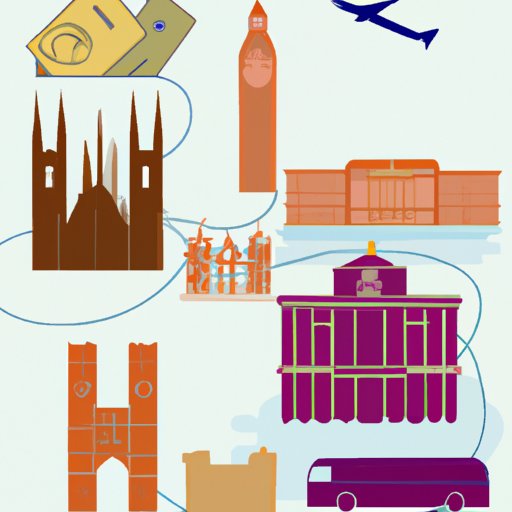Introduction
Traveling within Europe is an exciting experience filled with a variety of cultures, cuisines, and attractions. But what about the cost? Is it expensive or cheap to travel within Europe? The answer to this question depends on one’s definition of “cheap”. For some, “cheap” means spending as little money as possible, while for others, “cheap” simply means getting the most bang for your buck. This article will explore ways to make traveling within Europe more cost effective by comparing the cost of travel between European countries, exploring budget-friendly transportation options, examining how to save money on accommodation, investigating the cost of food and entertainment, and evaluating the cost of attractions and activities.

Comparing the Cost of Travel Between European Countries
The cost of travel between different European countries can vary greatly depending on several factors such as distance, currency exchange rate, and seasonality. Generally speaking, the farther a destination is from your starting point, the more expensive it will be to get there. Similarly, if the currency exchange rate is unfavorable, then prices for flights and other services may be higher than usual. Finally, traveling during peak tourist season may result in higher costs due to increased demand.
When it comes to average costs between countries, Western European countries tend to be more expensive than Eastern European countries. According to Numbeo’s 2020 Cost of Living Index, the most expensive country to visit in Europe is Switzerland, followed by Norway, Denmark, Iceland, and Luxembourg. On the other hand, the least expensive countries to visit in Europe are Bulgaria, Romania, Ukraine, Serbia, and Moldova. Of course, this is only an average and there are still plenty of ways to find cheaper travel options.
One way to save money when traveling within Europe is to book flights in advance. Many airlines offer discounted fares for travelers who book their tickets weeks or even months ahead of time. Additionally, it’s also a good idea to compare prices between different airlines and look for special deals and promotions. It’s also worth considering alternative airports that may be closer to your destination or may offer lower fares.
Exploring Budget-Friendly Transportation Options in Europe
Another great way to save money when traveling within Europe is to take advantage of budget-friendly transportation options. One of the most popular and cost-effective ways to get around Europe is by taking the train. Train travel has many advantages such as being faster than driving, offering spectacular views, and providing convenient access to major cities. Plus, many countries offer discounts and special offers on train tickets, making them a great way to save money.
If you’re looking for an even cheaper option, consider taking public transportation. Buses and trams are usually much cheaper than trains and they can be a great way to explore a city on a budget. In addition, many cities in Europe offer bike sharing programs that allow you to rent a bike for a small fee. This is a great way to get around without having to worry about transportation costs.
Finally, if you’re looking to fly within Europe, there are a number of budget airlines that offer cheap flights. Ryanair, EasyJet, and Wizz Air are just a few of the budget airlines that operate within Europe and offer discounted fares. Be sure to compare prices between different airlines to ensure you’re getting the best deal.
Examining How to Save Money on Accommodation in Europe
Accommodation can be one of the biggest expenses when traveling in Europe, but there are several strategies for finding affordable accommodation. One of the easiest and most cost-effective ways to save money is to stay in hostels or guesthouses. These types of accommodations usually offer shared rooms and basic amenities at a fraction of the cost of hotels. Additionally, many hostels and guesthouses offer discounts for long-term stays, so be sure to ask about any special offers.
Another way to save money on accommodation is to look for deals and discounts. Many websites such as Booking.com and Expedia offer discounts on hotel rooms, so be sure to check them out before booking. Additionally, some hotels offer loyalty programs that reward customers with discounts or free nights after a certain number of stays. If you plan to stay in the same area for an extended period of time, this could be a great way to save money.

Investigating the Cost of Food and Entertainment in Europe
When it comes to food and entertainment, Europe offers a wide variety of options at varying price points. From Michelin-starred restaurants to street food stalls, there is something for everyone. Prices can range from very cheap to very expensive depending on where you go and what you order. Generally speaking, fast food and street food tend to be the cheapest options, while fine dining restaurants are usually more expensive.
In terms of entertainment, there are plenty of things to do in Europe that won’t break the bank. Museums, galleries, and parks are all great options for those looking for a more cultural experience. Additionally, many cities have free walking tours that provide a great overview of the city’s history and culture. There are also a variety of festivals and events that are held throughout the year, many of which are free or offer discounted admission.
Finally, there are a few tips for eating cheaply while traveling in Europe. For example, try to avoid eating at touristy restaurants, as these tend to be more expensive. Instead, opt for local eateries or grocery stores, which usually offer better prices. Additionally, many restaurants offer lunch specials, so be sure to ask if this is available. And finally, don’t be afraid to ask locals for recommendations on where to eat, as they usually know the best places to get a good meal at a reasonable price.

Evaluating the Cost of Attractions and Activities in Europe
Europe is home to a plethora of attractions and activities, ranging from historical sites to outdoor adventures. While some attractions and activities are free, many require admission fees. However, there are several ways to save money on attractions and activities. For example, many museums and galleries offer discounts or free admission days, so be sure to check their websites for details. Additionally, many cities offer discount cards and passes that allow you to access multiple attractions for one low price. Finally, many attractions offer discounts for online purchases, so be sure to check their websites before you go.
Conclusion
Traveling within Europe can be an exciting and rewarding experience, but it can also be expensive if you’re not careful. To save money, it’s important to compare prices between different countries, take advantage of budget-friendly transportation options, find affordable accommodation, and take advantage of discounts and deals. Additionally, be sure to research the cost of food and entertainment in the area, as well as the cost of attractions and activities. By following these tips, you can maximize your savings and have a wonderful time exploring Europe.
(Note: Is this article not meeting your expectations? Do you have knowledge or insights to share? Unlock new opportunities and expand your reach by joining our authors team. Click Registration to join us and share your expertise with our readers.)
